The Moon is the Earth's natural satellite, orbiting around it every 27 days. It is also the fifth largest satellite in the Solar System. The Moon is only a quarter of the size of the Earth or it may be said that it is slightly bigger than the U.S.A. Its mass is 1/81 times of the Earth's. The moon is a cold, dry orb whose surface is studded with craters and strewn with rocks and dust (called regolith). The moon has no atmosphere. Recent lunar missions indicate that there might be some frozen ice at the poles.
If you were standing on the moon, the sky would always appear dark, even during the daytime. Also, from any spot on the moon (except on the far side of the moon where you cannot see the Earth), the Earth would always be in the same place in the sky; the phase of the Earth changes and the Earth rotates, displaying various continents.
Characteristics:
Two Lunar Months
The sidereal and synodic lunar months have different lengths. The sidereal month is the amount of time it takes the Moon to return to the same position in the sky with respect to the stars; the sidereal month is 27.321 days long. The synodic month is the time between similar lunar phases (e.g., between two full moons); the synodic month is 29.530 days long.
Moons Rocks
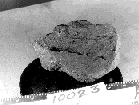 NASA astronauts have retrieved 842 pounds (382 kg) of moon rocks (in many missions), which have been closely studied. The composition of the moon rocks is very similar to that of Earth rocks. Using radioisotope dating, it has been found that moon rocks are about 4.3 billion years old.
NASA astronauts have retrieved 842 pounds (382 kg) of moon rocks (in many missions), which have been closely studied. The composition of the moon rocks is very similar to that of Earth rocks. Using radioisotope dating, it has been found that moon rocks are about 4.3 billion years old.
If you were standing on the moon, the sky would always appear dark, even during the daytime. Also, from any spot on the moon (except on the far side of the moon where you cannot see the Earth), the Earth would always be in the same place in the sky; the phase of the Earth changes and the Earth rotates, displaying various continents.
The Origin Of the Moon
Most scientists believe that the moon was formed from the ejected material after the Earth collided with a Mars-sized object. This ejected material coalesced into the moon that went into orbit around th Earth. This catastrophic collision occurred about 60 million years after Earth itself formed (about 4.3 billion years ago). This is determined by the radioisotope dating of moon rocks
Most scientists believe that the moon was formed from the ejected material after the Earth collided with a Mars-sized object. This ejected material coalesced into the moon that went into orbit around th Earth. This catastrophic collision occurred about 60 million years after Earth itself formed (about 4.3 billion years ago). This is determined by the radioisotope dating of moon rocks
The prevailing hypothesis today is that the Earth–Moon system formed as a result of a giant impact: a Mars-sized body hit the nearly formed proto-Earth, blasting material into orbit around the proto-Earth, which accreted to form the Moon. Giant impacts are thought to have been common in the early Solar System. Computer simulations modelling a giant impact are consistent with measurements of the angular momentum of the Earth–Moon system, and the small size of the lunar core; they also show that most of the Moon came from the impactor, not from the proto-Earth. However, meteorites show that other inner Solar System bodies such as Mars and Vesta have very different oxygen and tungsten isotopic compositions to the Earth, while the Earth and Moon have near-identical isotopic compositions. Post-impact mixing of the vaporized material between the forming Earth and Moon could have equalized their isotopic compositions, although this is debated.
- Rotational Period: 29 days 12 hours 44 mins 2.9 seconds
- Revolution Period: 27 days 7 hours 43 mins 6.2 seconds
- Speed: 1.022 km/s
- Radius: 1737.103 km
- Equatorial Radius: 1738.142 km
- Polar Radius: 1735.974 km
- Surface Area: 3.793 × 107 km2
- Escape Velocity: 2.38 km/s
- Volume: 2.1958 × 1010 km3
- Mass: 7.3477 × 1022 kg
- Acceleration due to gravity(g): 1.6300545 m/s2
The Moons Orbit:

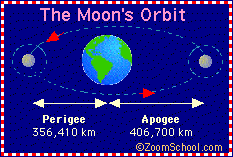 The moon is about 238,900 miles (384,000 km) from Earth on average. At its closest approach (the lunar perigee) the moon is 221,460 miles (356,410 km) from the Earth. At its farthest approach (its apogee) the moon is 252,700 miles (406,700 km) from the Earth.
The moon is about 238,900 miles (384,000 km) from Earth on average. At its closest approach (the lunar perigee) the moon is 221,460 miles (356,410 km) from the Earth. At its farthest approach (its apogee) the moon is 252,700 miles (406,700 km) from the Earth.
The moon revolves around the Earth in about one month (27 days 8 hours). It rotates around its own axis in the same amount of time. The same side of the moon always faces the Earth; it is in a synchronous rotation with the Earth.
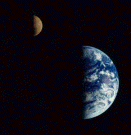 The Moon's orbit is expanding over time as it slows down (the Earth is also slowing down as it loses energy). For example, a billion years ago, the Moon was much closer to the Earth (roughly 200,000 kilometers) and took only 20 days to orbit the Earth. Also, one Earth 'day' was about 18 hours long (instead of our 24 hour day). The tides on Earth were also much stronger since the moon was closer to the Earth.
The Moon's orbit is expanding over time as it slows down (the Earth is also slowing down as it loses energy). For example, a billion years ago, the Moon was much closer to the Earth (roughly 200,000 kilometers) and took only 20 days to orbit the Earth. Also, one Earth 'day' was about 18 hours long (instead of our 24 hour day). The tides on Earth were also much stronger since the moon was closer to the Earth.
Saros
The saros is the roughly 18-year periodic cycle of the Earth-Moon-Sun system. Every 6,585 days, the Earth, Moon and Sun are in exactly the same position. When there is a lunar eclipse, there will also be one exactly 6,585 days later.
Mass and Gravity
The moon's mass is (7.35 x 10 22 kg), about 1/81 of the Earth's mass.
The moon's gravitational force is only 17% of the Earth's gravity. For example, a 100 pound (45 kg) person would weigh only 17 pounds (7.6 kg) on the Moon.
The moon's density is 3340 kg/m 3. This is about 3/5 the density of the Earth.
Temperature
The temperature on the Moon ranges from daytime highs of about 130°C = 265°F to nighttime lows of about -110°C = -170°F
Atmosphere
The moon has no atmosphere. On the moon, the sky is always appears dark, even on the bright side (because there is no atmosphere). Also, since sound waves travel through air, the moon is silent; there can be no sound transmission on the moon.
Craters and Rillers
The surface of the moon is scarred by millions of (mostly circular) impact craters, caused by asteroids, comets, and meteorites. There is no atmosphere on the moon to help protect it from bombardment from potential impactors (most objects from space burn up in our atmosphere). Also, there is no erosion (wind or precipitation) and little geologic activity to wear away these craters, so they remain unchanged until another new impact changes it.
These craters range in size up to many hundreds of kilometers, but the most enormous craters have been flooded by lava, and only parts of the outline are visible. The low elevation maria (seas) have fewer craters than other areas. This is because these areas formed more recently, and have had less time to be hit. The biggest intact lunar crater is Clavius which is 100 miles (160 km) in diameter.
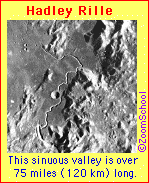 A rille is a long, narrow valley on the surface of the moon. Hadley Rille is a long valley on the surface of the moon. This rille is 75 miles (125 km) long, 1300 feet (400 m) deep, and almost 1 mile (1500 m) wide at its widest point. It was formed by molten basaltic lava that carved out a steep channel along the base of the Apennine Front (which was explored by the Apollo 15 astronauts in 1971).
A rille is a long, narrow valley on the surface of the moon. Hadley Rille is a long valley on the surface of the moon. This rille is 75 miles (125 km) long, 1300 feet (400 m) deep, and almost 1 mile (1500 m) wide at its widest point. It was formed by molten basaltic lava that carved out a steep channel along the base of the Apennine Front (which was explored by the Apollo 15 astronauts in 1971).
Moon or Double Planet?
The Earth and the Moon are relatively close in size (4:1 in diameter, 81:1 in mass), unlike most planet/moon systems. Many people consider the Earth and Moon to be a double planet system (rather than a planet/moon system). The moon does not actually revolve around the Earth; it revolves around the Sun in concert with the Earth (like a double planet system).
Libration
Libration is a rocking movement of the Moon. Librations cause us to view the Moon from different angles at different times, enabling us to see about 59 percent of the Moon's surface from Earth, even though the same side always faces us. There are librations due to variations in the rate of the Moon's orbital motion (longitudinal libration) and to the inclination of the Moon's equator with respect to its orbital plane (latitudinal libration). There is also an apparent libration due to an observer on Earth viewing the Moon from different angles as the Earth rotates (diurnal libration, which occurs each day)
.
The moon revolves around the Earth in about one month (27 days 8 hours). It rotates around its own axis in the same amount of time. The same side of the moon always faces the Earth; it is in a synchronous rotation with the Earth.
Saros
The saros is the roughly 18-year periodic cycle of the Earth-Moon-Sun system. Every 6,585 days, the Earth, Moon and Sun are in exactly the same position. When there is a lunar eclipse, there will also be one exactly 6,585 days later.
Mass and Gravity
The moon's mass is (7.35 x 10 22 kg), about 1/81 of the Earth's mass.
The moon's gravitational force is only 17% of the Earth's gravity. For example, a 100 pound (45 kg) person would weigh only 17 pounds (7.6 kg) on the Moon.
The moon's density is 3340 kg/m 3. This is about 3/5 the density of the Earth.
Temperature
The temperature on the Moon ranges from daytime highs of about 130°C = 265°F to nighttime lows of about -110°C = -170°F
Atmosphere
The moon has no atmosphere. On the moon, the sky is always appears dark, even on the bright side (because there is no atmosphere). Also, since sound waves travel through air, the moon is silent; there can be no sound transmission on the moon.
Craters and Rillers
The surface of the moon is scarred by millions of (mostly circular) impact craters, caused by asteroids, comets, and meteorites. There is no atmosphere on the moon to help protect it from bombardment from potential impactors (most objects from space burn up in our atmosphere). Also, there is no erosion (wind or precipitation) and little geologic activity to wear away these craters, so they remain unchanged until another new impact changes it.
These craters range in size up to many hundreds of kilometers, but the most enormous craters have been flooded by lava, and only parts of the outline are visible. The low elevation maria (seas) have fewer craters than other areas. This is because these areas formed more recently, and have had less time to be hit. The biggest intact lunar crater is Clavius which is 100 miles (160 km) in diameter.
Moon or Double Planet?
The Earth and the Moon are relatively close in size (4:1 in diameter, 81:1 in mass), unlike most planet/moon systems. Many people consider the Earth and Moon to be a double planet system (rather than a planet/moon system). The moon does not actually revolve around the Earth; it revolves around the Sun in concert with the Earth (like a double planet system).
Libration
Libration is a rocking movement of the Moon. Librations cause us to view the Moon from different angles at different times, enabling us to see about 59 percent of the Moon's surface from Earth, even though the same side always faces us. There are librations due to variations in the rate of the Moon's orbital motion (longitudinal libration) and to the inclination of the Moon's equator with respect to its orbital plane (latitudinal libration). There is also an apparent libration due to an observer on Earth viewing the Moon from different angles as the Earth rotates (diurnal libration, which occurs each day)
.
Two Lunar Months
The sidereal and synodic lunar months have different lengths. The sidereal month is the amount of time it takes the Moon to return to the same position in the sky with respect to the stars; the sidereal month is 27.321 days long. The synodic month is the time between similar lunar phases (e.g., between two full moons); the synodic month is 29.530 days long.
Moons Rocks





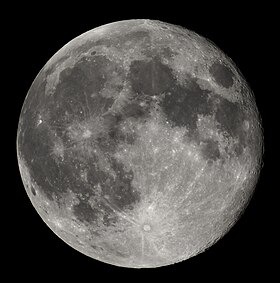


0 comments:
Post a Comment